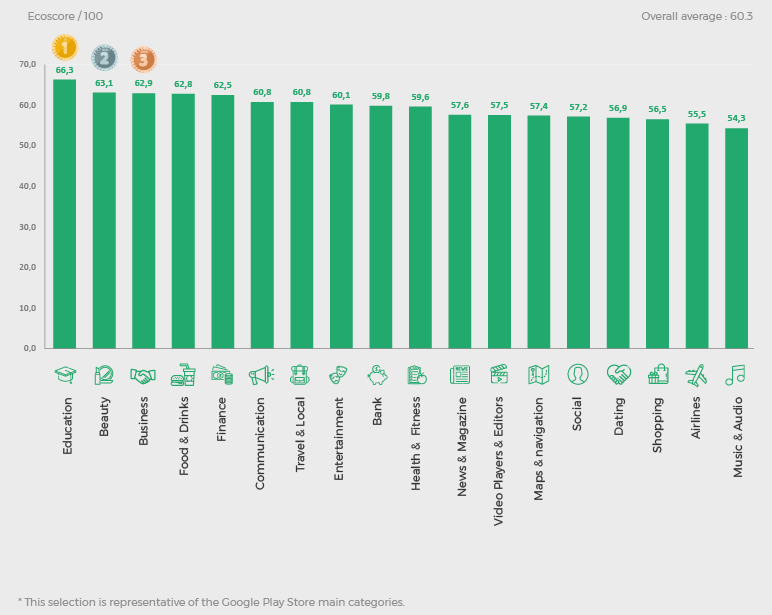Greenspector study of the energy consumption of Google Play Store mobile apps
During the Mobile One event, GREENSPECTOR announces a survey of the major mobile consumer trends of the Google Play Store. More than 1000 applications were sifted through for Performance, Sobriety and Inclusion by the measurement tools developed by GREENSPECTOR.
This unprecedented study highlights that:
- mobile applications contribute at least 6% of digital CO2 emissions,
- trackers, analytics and other ubiquitous permissions (44% of applications have more than 5 trackers) result in an extra consumption of on average 8.5% for each tracker added,
- a quarter of Google Play Store apps exclude 10% of the oldest mobiles,
- 50% of measured applications continue to process or send data after closing the application,
- some highly used and greedy applications can reduce the autonomy of the batteries to less than 3 hours,
For this new study, the GREENSPECTOR laboratory has chosen and tested a sample of more than 1000 applications in Android thanks to its different measurement tools. Each application has taken 100 control points to determine a global Ecoscore out of 100, the GREENSPECTOR App Mark which is the result of 5 measured criteria: sobriety, performance, discretion, ecology and inclusion. This way to design applications will cause a significant impact, both in terms of ecological footprint and smartphone autonomy or user experience.
New brands showcases are often the main point of entry for customers, whether the purchase materializes in the application or continues in store. A bad “user experience” inexorably translates into lower sales. The e-commerce sector is firstly concerned but branding; e-reputation and e-inclusion are also at stake as soon as the application is intended for the general public. The GREENSPECTOR study shows that the Google Play Store’s music & audio, airline and m-commerce applications have the highest environmental impact.

Some of the most efficient applications include: Youtube studio, SOS Médecin. For highly impactful applications, we can mention: Clash of Kings, NRJ Radio, Radio Nostalgie or the PSG application!
The biggest observations:
Carbon footprint: on average the applications have an impact of 0.75 g CO2eq (CO2 equivalent). For a projection of use of 3 hours per day by 5 billion mobile users, 92 million tons CO2eq are expected. Knowing that it takes into account neither the installation of the application nor the functional path to use the application, this minimized estimate shows that mobile applications represent at least 6% of digital CO2 emissions. In the sample, 90% of mobile applications have a low impact (less than 1 g CO2eq per unit of measure). However, the average of the sample is pulled up by 1% of the applications that have an impact higher than 10 g CO2eq per unit of measure, especially in the category of the games.
User impact and privacy: Trackers, analytics and other permissions are ubiquitous: on average 44% of applications have more than 5 trackers and 73% require more than 10 permissions. In the addition to the problems posed in terms of the security of personal data and their exploitation, these tools have a major impact on the energy consumption and resources of the mobile phone, leading to an additional environmental cost.
Software / mobile obsolescence: in this GREENSPECTOR survey, only 70% of the applications on the store are compatible with all versions of Android. A quarter of Google Play Store apps exclude 10% of older mobile devices. The inclusion rate of the average market for applications, meaning the percentage of applications compatible with the device / operating system park on Android, is 95.8%. Conversely in 4.2% of cases, applications will not be compatible with the global smartphone fleet.
Other findings:
It should be noted that more than 50% of measured applications continue to process or send data after the application closes. These are voluntary mailings (data backup on external servers, for example) or sometimes involuntary (non-controlled libraries in particular). An often useless overconsumption could jeopardize these applications. Manufacturers sensitive to this consumption in the background are less and less guilty by denouncing those who drain the batteries and impact their reputation in autonomy. Being denounced as an “Energy-sucking” application is a risk for the image of the brand. Especially since it is a reality; some highly used and greedy applications can reduce the autonomy of the batteries to less than 3 hours.
This unparalleled study of mobile applications the widely-held intuitions:
- The most discreet applications with few trackers and permissions are also the most inclusive applications with potential to broaden targets or a larger market by promoting more universal access to contents and services, that helps reduce the Digital Divide.
- The size of the application has no impact on its performance or on its energy consumption. On the other hand, these increase with frequent updates.
- The most powerful applications in terms of display time are generally the most ecological. But as soon as an application asks to use all the resources of a smartphone to be more efficient in display speed, it increases the energy demand and creates energy consumption and decreases the resources of the smartphone.

Digital Sobriety Expert
Books author «Green Patterns», «Green IT – Gérer la consommation d’énergie de vos systèmes informatiques», …
Speaker (VOXXED Luxembourg, EGG Berlin, ICT4S Stockholm, …)
Green Code Lab Founder, ecodesign software national association
